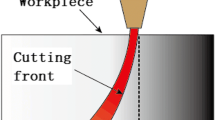Abstract
Abrasive waterjet cutting operates by the impingement of a high-velocity abrasive-laden waterjet against the workpiece. The jet is formed by mixing abrasive particles with high-velocity water in mixing tubes and is forced through a tiny sapphire orifice. The accelerated jet exiting the nozzle travels at more than twice the speed of sound and cuts as it passes through the workpiece.
This cutting process is being developed as a net-shape and near-net-shape machining process for cutting many metals and hard-to-machine materials. The narrow kerf produced by the stream results in neither delimitation nor stresses along the cutting path. This new technology offers significant advantages over traditional processes for its ability to cut through most sections of dense or hard materials without the need for secondary machining, to produce contours, and to be integrated into computer-controlled systems.
The abrasive waterjet cutting process involves a large number of process and material parameters which are related to the waterjet, the abrasive particles, and workpiece material. Those parameters are expected to effect the material removal rates and the depth of cut. The purpose of the present work is to propose a model which is capable of predicting the maximum depth of cut for different types of materials using different process parameters. A comparison of the results of the proposed model and the models reported in the literature is introduced along with a discussion of the limitations of those models.
Similar content being viewed by others
References
P. G. Nikonov and A. Y. Goldin, “Coal and rock penetration by fire continuous high pressure water jet”,Proceedings of the 1st International Jet Cutting Symposium, BHRA Fluid Engineering, 1972.
S. C. Crow, “A study of hydraulic rock cutting”,International Journal of Rock Mechanics and Mining Sciences, 10, 1973.
G. Rehbinder, “Some aspects on the mechanism of erosion of rock with a high speed waterjet”,Third International Symposium on Jet Cutting Technology, BHRA, 1976.
M. Hashish, “A model for abrasive waterjet (AWJ) machining”,Journal of Engineering Materials and Technology 111, pp. 155–161, 1989.
M. Hashish, “An improved model for erosion by solid particle impact”,Proceedings of the Seventh International Conference on Erosion by Liquid and Solid Impact ELSI VII, Cambridge, England, pp. 66/1–66/9, September 1987.
C. Preece (ed.) “Treatise on material science and technology”,Erosion, vol. 16, Academic Press, New York, pp. 69–126, 1979.
G. I. Sheldon and I. Finnie, “On the brittle behavior of nominally brittle materials during erosine cutting”,ASME Journal of Engineering for Industry, pp. 387–392, November 1966.
J. Zeng and T. J. Kim, “A study of brittle mechanism applied to abrasive waterjet processes”,Proceedings of the 10th International Symposium on Jet Cutting Technology BHRA Amsterdam, October 31–November 2, pp. 115–133, 1990.
T. Zeng and T. J. Kim, “Materials removal of polycrystalline ceramics by a high pressure abrasive waterjet — a SEM study”,International Journal of Waterjet Technology, 2,(1), 1992.
J. Zeng and T. J. Kim, “Development of an abrasive waterjet kerf cutting model for brittle materials”,11th International Conference on Jet Cutting Technology, St Andrews, Scotland, 8–10 September 1992, pp. 483–501.
J. G. A. Bitter, “A study of erosion phenomena — Part I”,Wear 6, pp. 5–21, 1963.
I. Finnie, “The mechanism of erosion of ductile materials”,Proceedings of the 3rd National Congress of Applied Mechanics, ASME, pp. 527–532, 1958.
M. Hashish, “The effect of beam angle in abrasive waterjet machining”,Journal of Engineering for Industry 115, pp. 51–56, February 1993.
R. J. Wilkins and E. E. Graham, “An erosion model for waterjet cutting”,Journal of Engineering for Industry 115, pp. 57–61, February 1993.
R. Groppettie and F. Jovane, “Hydro-abrasive jet machining modeling for computer control and optimization”,Journal of Materials Engineering and Performance 2(3), pp. 421–436, June 1993.
M. Kitamura et al. “Cutting of steam turbine components using abrasive waterjet”,11th International Conference on Jet Cutting Technology, St Andrews, Scotland, 8–10 September, 1992, pp. 543–554.
R. Kovacevic, “Monitoring of depth of abrasive waterjet penetration”,Int. Journal of Machine Tools and Manufacture 32(5), pp. 725–736, 1992.
Y. Chung and E. S. Geskin, “Prediction of the geometry of the kerf created in the course of abrasive waterjet machining of ductile materials”,11th International Conference on Jet Cutting Technology, St Andrews, Scotland, 8–10 September 1992, pp. 525–541.
Author information
Authors and Affiliations
Additional information
On leave from: Mechanical Engineering Department, Suez Canal University, Egypt.
On leave from: Industrial Production Engineering Department, Mansoura University, Egypt.
On leave from: Mechanical Power Engineering Department, Alexandria University, Egypt.
Rights and permissions
About this article
Cite this article
El-Domiaty, A.A., Shabara, M.A., Abdel-Rahman, A.A. et al. On the modelling of abrasive waterjet cutting. Int J Adv Manuf Technol 12, 255–265 (1996). https://doi.org/10.1007/BF01239612
Issue Date:
DOI: https://doi.org/10.1007/BF01239612




